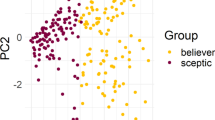Abstract
A sample of 279 13- to 16-year-old adolescents completed the Short-form Revised Junior Eysenck Personality Questionnaire (JEPQR-S) and a six-item Index of Paranormal Belief. The data demonstrate that neuroticism is fundamental to individual differences in paranormal belief, while paranormal belief is independent of extraversion and psychoticism.
Similar content being viewed by others
References
Boyd, A. (1996). Dangerous obsessions: Teenagers and the occult. London: Marshall Pickering.
Corulla, W. J. (1990). A revised version of the psychoticism scale for children. Personality and Individual Differences, 11, 65–76.
Eysenck, H. J., & Eysenck, S. B. G. (1991). Manual of the Eysenck personality scales (EPS Adult). London: Hodder and Stoughton.
Francis, L. J. (1992). Is psychoticism really a dimension of personality fundamental to religiosity? Personality and Individual Differences, 13, 645–654.
Francis, L. J. (1993). The dual nature of the Eysenckian neuroticism scales: A question of sex differences. Personality and Individual Differences, 14, 43–59.
Francis, L. J. (2001). The values debate: A voice from the pupils. London: Woburn.
Francis, L. J., & Jackson, C. J. (2003). Eysenck’s dimensional model of personality and religion: Are religious people more neurotic. Mental Health, Religion and Culture, 6, 87–100.
Francis, L. J., & Kay, W. K. (1995). Teenage religion and values. Leominster: Gracewing.
Francis, L. J., & Pearson, P. R. (1985). Psychoticism and religiosity among 15-year olds. Personality and Individual Differences, 6, 397–398.
Francis, L. J., & Pearson, P. R. (1991). Religiosity, gender and the two faces of neuroticism. Irish Journal of Psychology, 12, 60–67.
Francis, L. J., Pearson, P. R., Carter, M., & Kay, W. K. (1981a). The relationship between neuroticism and religiosity among English 15- and 16- year olds. The Journal of Social Psychology, 114, 99–102.
Francis, L. J., Pearson, P. R., Carter, M., & Kay, W. K. (1981b). Are introverts more religious. British Journal of Social Psychology, 20, 101–104.
Francis, L. J., Pearson, P. R., & Kay, W. K. (1983a). Are introverts still more religious. Personality and Individual Differences, 4, 211–212.
Francis, L. J., Pearson, P. R., & Kay, W. K. (1983b). Are religious children bigger liars. Psychological Reports, 52, 551–554.
Höllinger, F., & Smith, T. B. (2002). Religion and esotericism among students: A cross-cultural comparative study. Journal of Contemporary Religion, 17, 229–249.
Kay, W. K. (1981). Psychoticism and attitude to religion. Personality and Individual Differences, 2, 249–252.
Lester, D. (1993). Paranormal beliefs and psychoticism. Personality and Individual Differences, 14, 739.
Peltzer, K. (2003). Magical thinking and paranormal beliefs among secondary and university students in South Africa. Personality and Individual Differences, 35, 1419–1426.
Preece, F. W., & Baxter, J. H. (2000). Scepticism and gullibility: The superstitious and pseudo-scientific beliefs of secondary school students. International Journal of Science Education, 22, 1147–1156.
Quesnell, M. D. (2000). An analysis of selected beliefs and values among Czech 14 and 15 year-old public school students. Ph.D. thesis, University of Wales, Trinity College.
Sjödin, U. (2002). The Swedes and the paranormal. Journal of Contemporary Religion, 17, 75–85.
Smith, A. G. C. (2002). The religion of adolescents in Walsall. Bangor: Ph.D. thesis, University of Wales.
Thalbourne, M. A., & Hensley, J. H. (2001). Religiosity and belief in the paranormal. Journal of the Society for Psychical Research, 65, 47.
Willging, B. T., & Lester, D. (1997). Paranormal beliefs and personality scores of high school students. Perceptual and Motor Skills, 85, 938.
Williams, E., Francis, L. J., & Robbins, M. (2006). Attitude toward Christianity and paranormal belief among 13- to 16-year-old students. Psychological Reports, 99, 266.
Wiseman, R., & Watt, C. (2004). Measuring superstitious belief: Why lucky charms matter. Personality and Individual Differences, 37, 1533–1541.
Wolfradt, U. (1997). Dissociative experiences, trait anxiety and paranormal belief. Personality and Individual Differences, 23, 15–19.
Author information
Authors and Affiliations
Corresponding author
Rights and permissions
About this article
Cite this article
Williams, E., Francis, L.J. & Robbins, M. Personality and Paranormal Belief: A Study Among Adolescents. Pastoral Psychol 56, 9–14 (2007). https://doi.org/10.1007/s11089-007-0094-x
Published:
Issue Date:
DOI: https://doi.org/10.1007/s11089-007-0094-x




